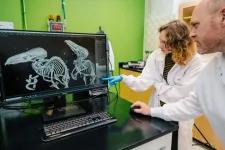(Press-News.org) People with a certain heart valve abnormality are at increased risk of severe heart rhythm disorders, even after successful valve surgery. This is according to a new study from Karolinska Institutet and Karolinska University Hospital in Sweden published in the European Heart Journal. The condition is more common in women and younger patients with valve disorder and can, in the worst case, lead to sudden cardiac arrest.
Mitral annular disjunction, MAD, is a heart abnormality in which the mitral valve attachment ‘slides’. In recent years, the condition has been linked to an increased risk of severe cardiac arrhythmias. Until now, it has not been known whether the risk of arrhythmias disappears if MAD is surgically corrected.
MAD is often associated with a heart disease called mitral valve prolapse, which affects 2.5 percent of the population and causes one of the heart’s valves to leak. This can lead to blood being pumped backwards in the heart, causing heart failure and arrhythmias. The disease can cause symptoms such as shortness of breath and palpitations.
Followed patients after surgery
In the current study, researchers at Karolinska Institutet investigated the risk of cardiac arrhythmias in 599 patients with mitral valve prolapse who underwent heart surgery at Karolinska University Hospital between 2010 and 2022. 16 percent of the patients also had the cardiac abnormality MAD.
“We have been able to show that people with MAD have a significantly higher risk of suffering from ventricular arrhythmias, a dangerous type of heart rhythm disorder that in the worst case can lead to cardiac arrest in a subset of patients,” says Bahira Shahim, associate professor at the Department of Medicine, Solna, Karolinska Institutet and cardiologist at Karolinska University Hospital.
People with MAD were more likely to be female and were on average eight years younger than those without MAD. They also had more extensive mitral valve disease. Although the surgery was successful in correcting MAD, these patients had more than three times the risk of ventricular arrhythmias during five years of follow-up compared to patients without preoperative MAD.
“Our results show that it is important to closely monitor patients with this condition, even after a successful operation,” says Bahira Shahim.
Investigating several hypotheses
The study has led to new hypotheses that the researchers are now investigating further. One hypothesis is that MAD causes permanent changes in the heart muscle over time. Another is that MAD is a sign of an underlying heart muscle disease. The researchers are now continuing to study scarring in the heart using MRI (magnetic resonance imaging) and analyse tissue samples from the heart muscle.
The research was led by cardiologist and associate professor Bahira Shahim in close collaboration with Magnus Dalén, associate professor at Karolinska Institutet and cardiac surgeon at Karolinska University Hospital, and Klara Lodin, PhD student at Karolinska Institutet. It was financed by ALF funds, the Swedish Heart-Lung Foundation, the Swedish Research Council, the Swedish Society for Medical Research, the Swedish Society of Medicine and Karolinska Institutet. See the scientific article for information about potential conflicts of interest.
Publication: “Mitral annular disjunction and mitral valve prolapse: long-term risk of ventricular arrhythmias after surgery”, Klara Lodin, Cristina Da Silva, Anne Wang Gottlieb, Ivana Bulatovic, Andreas Rück, Isaac George, David J. Cohen, Frieder Braunschweig, Peter Svenarud, Maria J. Eriksson, Kristina H. Haugaa, Magnus Dalén, Bahira Shahim, European Heart Journal, online 15 April 2025, doi: 10.1093/eurheartj/ehaf195.
END
Heart valve abnormality is associated with malignant arrhythmias
2025-04-15
ELSE PRESS RELEASES FROM THIS DATE:
Explainable AI for ship navigation raises trust, decreases human error
2025-04-15
The Titanic sunk 113 years ago on April 14-15, after hitting an iceberg, with human error likely causing the ship to stray into those dangerous waters. Today, autonomous systems built on artificial intelligence can help ships avoid such accidents, but could such a system explain to the captain why it was maneuvering a certain way?
That’s the idea behind explainable AI, which should help human actors trust autonomous systems more. Researchers from Osaka Metropolitan University’s Graduate School of Engineering have developed an explainable AI model for ships that quantifies the collision risk for all vessels ...
Study reveals erasing inequality could prevent hundreds of adverse births annually in major UK city
2025-04-15
In Birmingham, 43% of the population live in the most deprived 10% of neighborhoods in England. It is well known that deprivation can lead to adverse pregnancy outcomes, including low birth weight, premature birth, stillbirths, and neonatal mortality.
Now, researchers there examined the association between demographic, socioeconomic, and lifestyle factors and the risk of adverse birth outcomes in Birmingham and neighboring Solihull, an area much less affected by deprivation.
“Within the study population, there were significant differences in the odds of adverse birth outcomes and the risk factors of adverse birth outcomes by ethnicity ...
No “uncanny valley” effect in science-telling AI avatars
2025-04-15
If you’re among the 1.5 billion people worldwide using TikTok, you may have come across exceptional “testimonials” like Nikola Tesla or Marie Curie delivering short science-related messages that have garnered millions of views. This is just one of many examples where AI-generated avatars are used to communicate science — a strategy that might also have its drawbacks.
The generation of images and animations through artificial intelligence is a rapidly growing field, constantly improving in quality. Yet many avatars, though realistic, still present minor flaws — glitches, delays, inconsistent ...
New UNCG research shows southern shrews shrink in winter
2025-04-15
Newly published research from UNC Greensboro biology professor Dr. Bryan McLean and colleagues shows that the masked shrew, a small, mole-like mammal found in the Appalachian Mountains, shrinks its body and braincase to conserve energy during winter months. The study, published in the May 2025 issue of The American Naturalist, found that the masked shrew (Sorex cinereus) reduces its body mass by 13 percent in the colder months; the creature then grows larger in spring when conditions improve. In addition to a shrinking body, the team also found seasonal changes in the height of the creature’s ...
Children exposed to brain-harming chemicals while sleeping
2025-04-15
Babies and young children may breathe and absorb plasticizers called phthalates, flame retardants, and other harmful chemicals from their mattresses while they sleep, according to a pair of peer-reviewed studies published today from the University of Toronto in Environmental Science & Technology and Environmental Science & Technology Letters. These chemicals are linked to neurological and reproductive problems, asthma, hormone disruption, and cancer.
"Sleep is vital for brain development, ...
Emotions and levels of threat affect communities’ resilience during extreme events
2025-04-15
Hoboken, N.J., April 14, 2025 — Tightly connected communities tend to be more resilient when facing extreme events such as earthquakes, hurricanes, floods or wildfires, says Jose Ramirez-Marquez, who develops metrics to analyze, quantify and ultimately improve performance of urban systems.
Ramirez-Marquez, associate professor and division director of Enterprise Science and Engineering at Stevens, who grew up in the earthquake-prone Mexico City knows this first-hand. “Whenever there's an earthquake, a city-wide alarm goes off and everybody leaves wherever they are and stays in the middle of the street — that’s a prevention phase,” he says. ...
New CONSORT reporting guidelines published today in five medical journals
2025-04-14
Under embargo until 23:30 (UK), Monday April 14, 2025
An updated set of guidelines to improve transparency and clarity in the reporting of randomised controlled trials have been published today. The CONSORT (Consolidated Standards of Reporting Trials) 2025 statement provides a minimum set of essential items that should be included when reporting the results of randomised trials.
First published in 1996, the CONSORT guidelines saw additional updates in 2001 and 2010. Becoming the gold standard for reporting randomised trials, ...
Experts stress importance of vaccination amidst measles outbreaks
2025-04-14
Pediatric infectious diseases experts stress the importance of vaccination against measles, one of the most contagious viruses, which is once more spreading in the United States. In the article published in Pediatrics, they update pediatricians on this vaccine-preventable disease, which was previously declared non-endemic in the U.S.
“The most effective way to prevent measles is vaccination,” said lead author Caitlin Naureckas Li, MD MHQS, infectious diseases specialist at Ann & Robert H. Lurie Children’s Hospital of Chicago and Assistant Professor of Pediatrics at Northwestern University ...
Enabling stroke victims to 'speak': $19 million toward brain implants to be built at U-M
2025-04-14
Images
A new collaboration between the University of Michigan and Stanford University aims to give stroke patients the ability to "speak" by detecting and interpreting brain signals, using the world's smallest computers linked up to the world's most biocompatible sensors.
The Marcus Foundation announced today a $29.7 million grant, led by Stanford, that would benefit victims of aphasic stroke, who are often left struggling to communicate. U-M will receive $19 million of the total grant.
According to the American Heart Association, stroke is the leading cause of disability in the ...
Study captures sharp uptake in use of new weight loss and glucose-lowering medications
2025-04-14
When it comes to managing weight loss and type 2 diabetes with medications, research shows that it’s out with the old and in with the new. Investigators from Mass General Brigham looked at claims data from nearly 2 million people between 2021 and 2023 and their findings highlight a shifting landscape for weight loss and glucose managing medications. Those changes include a sharp climb in the use of newly approved medications, especially tirzepatide, which is sold under the brand name Mounjaro for diabetes treatment and Zepbound for weight loss. The use of medications previously common in the treatment of type 2 diabetes, including metformin, sulfonylureas, and insulin, decreased. Results ...


